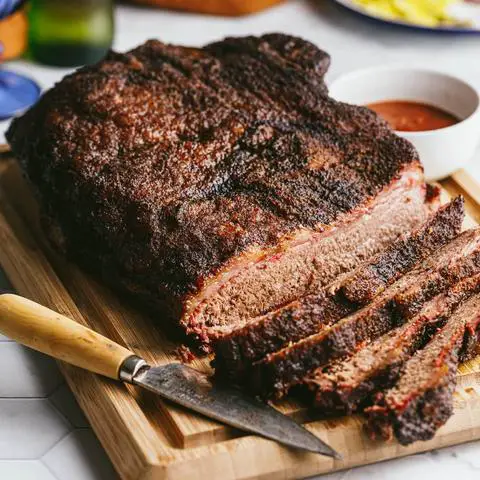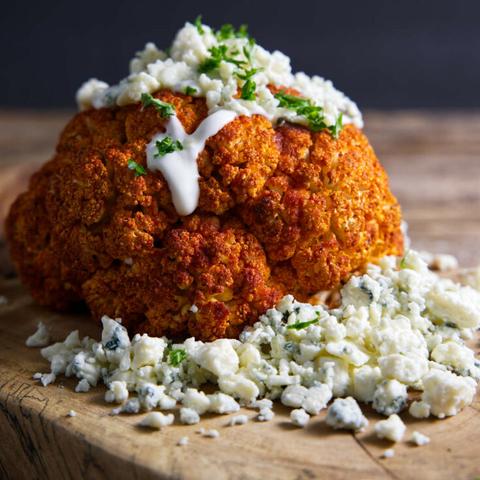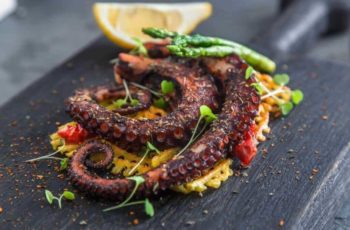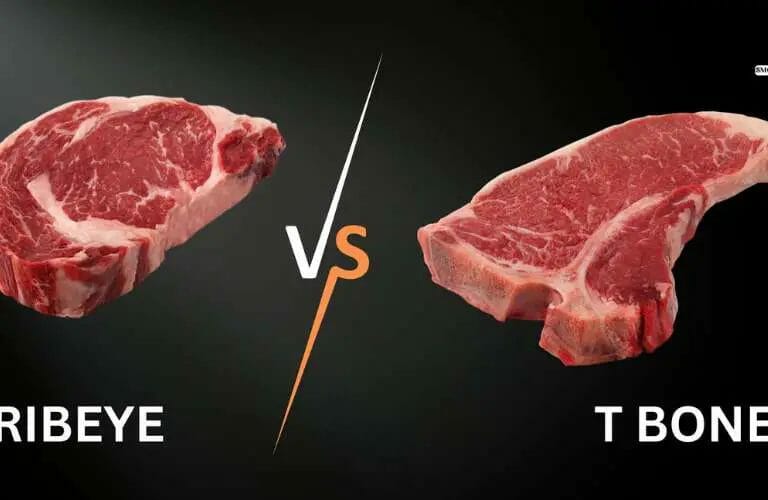
“T-Bone vs. Ribeye: The Ultimate Beef Battle Unveiled! Discover the distinctive characteristics, flavors, and cooking techniques that set these two beloved steak cuts apart. Whether you’re a meat connoisseur or simply seeking the perfect cut for your next grill-out, join us on an epic culinary journey to explore the mouthwatering differences between T-Bone and Ribeye steaks.”
T-Bone vs Ribeye Steak: The Differences Explained
When comparing T-bone and Ribeye steaks, the most obvious difference is the central bone found within the T-bone. The T-bone steak is sourced from the forward end of the short loin, while the Ribeye steak comes from the beef rib (ribs 6-12). Both steaks contain the longissimus dorsi muscle, but they differ in overall muscle composition. The T-bone also has a “T-shaped” bone, which is a result of splitting the lumbar vertebra through the vertebral column.

The T-bone steak consists of two muscles: the longissimus dorsi (NY strip) and the psoas muscle (tenderloin). These muscles are sold separately as prized cuts. On the other hand, ribeye steaks can be fabricated in different ways depending on which part of the rib primal they come from. They can include various muscles such as the longissimus dorsi and may even be marketed as “ribeye filet” when separated from other muscles.
Despite their differences in muscle composition, both T-bone and Ribeye steaks are popular choices among consumers. Factors like bone inclusion or thickness may influence people’s preferences when buying steaks. While marketing measures like frenched bones or unique names (e.g., “Tomahawk” or “Cowboy”) can drive up prices for ribeye steaks, T-bones often sell themselves without these additional marketing tactics. Additionally, both types of steaks are usually priced similarly per pound and fabricated into comparable weights/thicknesses.
What is the T-bone Steak?
The T-bone steak is a popular and recognizable cut of beef that is sourced from the short loin primal of the cow. It gets its name from the characteristic T-shaped bone that runs through the center of the steak. This bone is a result of sawing the lumbar vertebra in half through the vertebral column, creating a transverse process in the shape of a T.
The T-bone steak consists of two main muscles: the longissimus dorsi (also known as NY strip or short loin) and the tenderloin. These muscles are sold separately as prized cuts and have their own unique characteristics. The size and composition of these muscles can vary depending on where they are located within the short loin primal.
T-bone steaks are known for their tenderness and flavor, with some people enjoying the experience of gnawing on meat directly off the bone. They are generally 3/4 to 1 inch thick and weigh around 1.5 pounds.
What Muscles Make up the T-bone Steak?
The T-bone steak is made up of two main muscles, the Longissimus dorsi and the Psoas muscle. The Longissimus dorsi, also known as the NY strip or short loin, is a prized cut of meat that is tender and flavorful. The Psoas muscle, also known as the tenderloin, is smaller in size and tapers towards the front of the cow. This means that T-bone steaks will have smaller Psoas muscles compared to other cuts of steak. Overall, these two muscles contribute to the unique composition and taste of the T-bone steak.
It’s important to note that the Longissimus dorsi muscle is also found in ribeye steaks, where it is referred to as the “eye” of the ribeye steak. However, in T-bone steaks, this muscle is sourced from the forward end of the short loin primal. On a beef carcass, rib steaks are taken from the beef rib primal, which is located at the forequarter of the cow. Ribeye steaks are essentially made from meat sourced from ribs 6-12. The composition of a ribeye steak can vary depending on which part of the rib primal it came from.
In conclusion, understanding the different muscles that make up T-bone and ribeye steaks can help consumers appreciate their unique characteristics and flavors. Both cuts are highly valued in terms of taste and tenderness. Additionally, factors such as bone inclusion or thickness can influence consumer preferences and prices in the market.
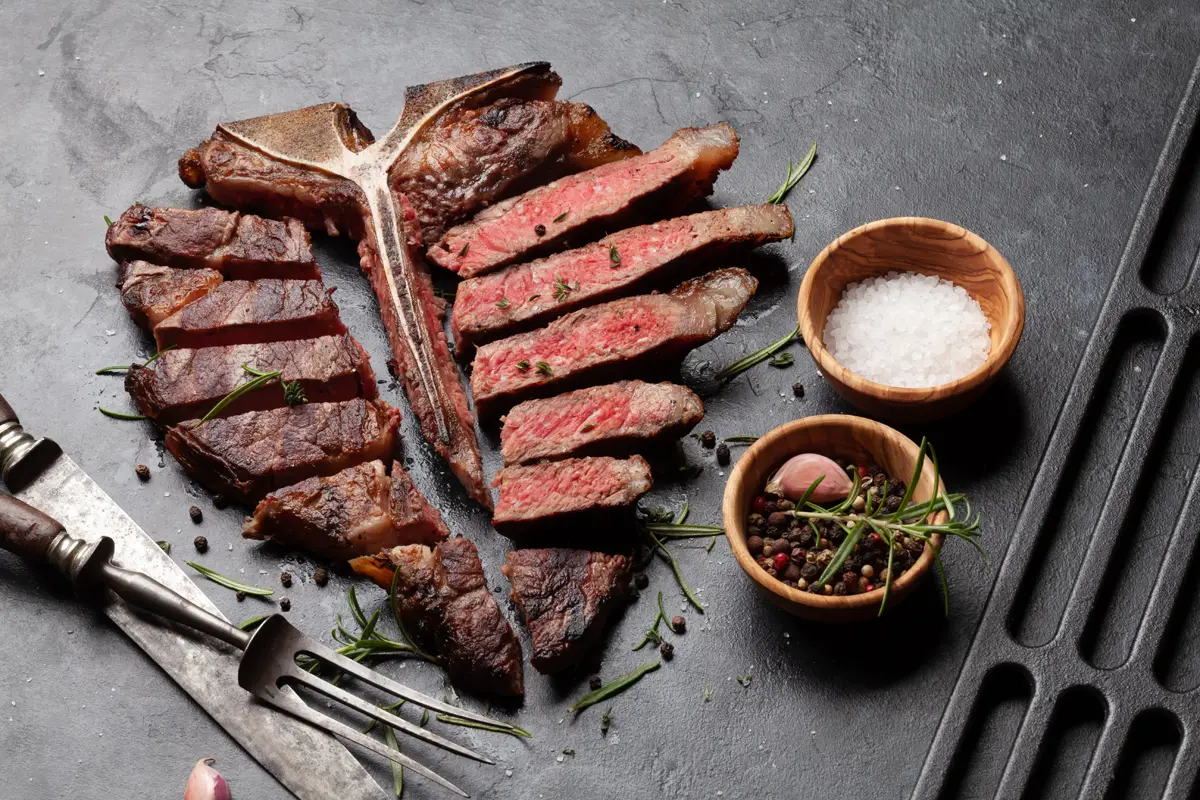
What is a Ribeye Steak?
A ribeye steak is a cut of beef sourced from the rib section of the cow, specifically ribs 6-12. It is known for its rich flavor and tenderness, making it a popular choice among steak lovers. The ribeye steak consists of several muscles, including the longissimus dorsi (the main muscle) and the spinalis dorsi (also known as the ribeye cap). These muscles contribute to the marbling and juiciness of the meat.
Ribeye steaks can be fabricated in various ways, depending on personal preference and market demand. They can be bone-in or boneless, thick or thin. Bone-in ribeye steaks can even be frenched, where the bones are exposed for an attractive presentation. This style of steak may be marketed under names like “Tomahawk” or “Cowboy” to enhance its appeal and price.
In terms of tenderness, the ribeye steak is considered to be highly desirable due to its location on the cow. Muscles that are further away from the legs and hooves tend to be more tender since they are not used for movement. The ribeye is also well-marbled with fat, which adds flavor and juiciness to the meat.
What Muscles Make up the Ribeye Steak?
The ribeye steak is comprised of several muscles. The amount of each muscle present in the steak will depend on which part of the rib primal it came from. A typical ribeye steak includes the longissimus dorsi muscle, which is the main portion of the steak. Additionally, there may be other muscles such as the spinalis dorsi (rib cap) and the complexus muscle. These muscles contribute to the overall flavor and tenderness of the ribeye steak.
The longissimus dorsi muscle is often referred to as the “eye” of the ribeye steak. It is a well-marbled and tender muscle that runs along the spine of the animal. This muscle provides much of the rich beefy flavor that ribeye steaks are known for.
The spinalis dorsi, also known as the rib cap, is a highly prized muscle found on top of the longissimus dorsi. It has a higher fat content and more marbling than other parts of the steak, making it incredibly flavorful and juicy.
The complexus muscle is located near the neck area of the animal and can sometimes be found in ribeye steaks. It is a leaner muscle with less marbling but still adds to the overall taste and texture of the steak.
Overall, these different muscles work together to create a delicious and tender ribeye steak that meat lovers enjoy.
The Importance of Beef Fabrication in the Sales of Meat
Beef fabrication plays a crucial role in the sales of meat. Butchers need to understand the different cuts and muscles in order to maximize the value of a beef carcass. When it comes to popular cuts like T-bone and Ribeye steaks, consumers are often drawn to the appearance of the meat, whether it includes a bone or has a certain thickness. Marketing measures such as frenching the bone or giving unique names like “Tomahawk” or “Cowboy” can further drive up the price of these steaks.
Understanding how beef carcasses are divided into retail cuts is essential when considering the price of steak. Both Ribeye and T-bone steaks usually fall within a similar price range per pound and are fabricated into similar weights and thicknesses. The number of steaks that can be obtained from a beef carcass also affects the price. For example, T-bone steaks must have a tenderloin that is 0.5″ thick according to USDA guidelines, which means fewer steaks can be cut from each carcass compared to other cuts like flank steak or filet mignon.
In terms of tenderness, while the inclusion of tenderloin in T-bone steaks may lead some people to assume they are more tender, overall muscle composition and usage indicate that ribeye steaks tend to be more tender than T-bones. Ribeye steaks come from distal points on the animal where muscles aren’t used for movement, making them more tender. Additionally, ribeye steaks contain more strip steak than tenderloin, which contributes to their tenderness and flavor.
Differences in Price
The price of T-bone steaks and ribeye steaks is usually around the same, with only a slight difference of +/- $1 per pound. This means that they are generally priced similarly in the market.
Factors that can affect the price of steak include tenderness, fat content, and the number of steaks that can be obtained from a beef carcass. Both T-bone and ribeye steaks are typically fabricated into similar weights and thicknesses, ranging from 3/4 to 1 inch thick.
It’s important to note that bone-in ribeye steaks, such as tomahawk or cowboy steaks, may have a higher price due to their unique presentation and marketing strategies. However, when comparing non-frenched, bone-in ribeye steaks to boneless ribeye steaks, they are generally priced the same per pound.
Differences in Tenderness
When it comes to tenderness, the ribeye steak is generally considered to be more tender than the T-bone steak. This is primarily due to the fact that the ribeye is taken from a more distal point on the animal, meaning it is further away from the legs and hooves. Muscles that are not used for movement tend to be more tender, and since the ribeye is located in the center of the animal, it is inherently more tender than the T-bone.
Additionally, the longissimus dorsi muscle in a ribeye steak is typically more tender than in a T-bone steak. While both cuts contain a tenderloin muscle (the psoas muscle), the spinalis dorsi muscle in a ribeye steak adds an extra layer of tenderness and flavor. The higher fat content in the spinalis dorsi contributes to its rich flavor and tenderness.
Furthermore, ribeye steaks are not separated from each other like T-bones or porterhouses are when it comes to their spinalis size. This means that you can choose ribeye steaks with better muscle composition without having to pay a higher price for them.
Differences in Taste
When it comes to taste, the ribeye steak is often considered superior. It has a beefy flavor that is rich and intense, making it a favorite among steak lovers. The ribeye steak also tends to be more tender than the T-bone steak, thanks to its location on the animal and the muscles it contains.
The longissimus dorsi muscle in the ribeye steak is known for its tenderness, while the spinalis dorsi (or ribeye cap) adds an extra layer of flavor due to its higher fat content. The combination of tenderness and richness in flavor makes the ribeye steak highly desirable.
In comparison, while the T-bone steak does contain the tenderloin muscle (also known as filet mignon), which is prized for its tenderness, it lacks the same level of flavor as the ribeye. The other muscle in the T-bone, known as NY strip or short loin, is not as tender or flavorful as the longissimus dorsi found in the ribeye.
In conclusion, when it comes to the T-bone vs. ribeye debate, both cuts of meat offer unique flavors and textures. While the T-bone steak combines the tenderness of the filet mignon with the richness of the strip loin, the ribeye steak boasts marbling that enhances its juiciness and robust taste. Ultimately, personal preference plays a key role in choosing between these two delicious options.
N/A
Learn More About Grilling
If you want to learn more about grilling, check out these other helpful resources!

